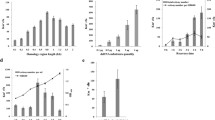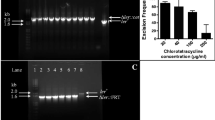Abstract
The Red recombinase system, the most convenient genetic tool applied in Escherichia coli and other bacteria, was introduced for gene replacement in Klebsiella pneumoniae. The novel K. pneumoniae gene replacement system comprised the Red and FLP recombinases expression vector pDK6-red and pDK6-flp, and linear DNA fragments which encompassed a selective marker gene with target gene flanking extensions; the latter were PCR amplified using a plasmid DNA template obtained by in vivo recombination in E. coli. In this study, dhak1 gene, encoding a subunit of dihydroxyacetone kinase II, was deleted markerlessly at a transformation ratio of 260 CFU/μg DNA, i.e., 1,000-fold higher than that achieved in the native way. Our studies provide an efficient method with detailed protocol to perform gene replacement in K. pneumoniae and has great potential to be developed as a routine genetic approach for this important industrial microorganism.

Similar content being viewed by others
References
Celinska E (2010) Debottlenecking the 1,3-propanediol pathway by metabolic engineering. Biotechnol Adv 28(4):519–530
Chaveroche MK, Ghigo JM, d’Enfert C (2000) A rapid method for efficient gene replacement in the filamentous fungus Aspergillus nidulans. Nucleic Acids Res 28(22):e97
Cherepanov PP, Wackernagel W (1995) Gene disruption in Escherichia coli: TcR and KmR cassettes with the option of Flp-catalyzed excision of the antibiotic-resistance determinant. Gene 158(1):9–14
Datsenko K, Wanner B (2000) One-step inactivation of chromosomal genes in Escherichia coli K-12 using PCR products. Proc Nat Acad Sci 97(12):6640
Derbise A, Lesic B, Dacheux D, Ghigo JM, Carniel E (2003) A rapid and simple method for inactivating chromosomal genes in Yersinia. FEMS Immunol Med Microbiol 38(2):113–116
Doublet B, Douard G, Targant H, Meunier D, Madec JY, Cloeckaert A (2008) Antibiotic marker modifications of [lambda] Red and FLP helper plasmids, pKD46 and pCP20, for inactivation of chromosomal genes using PCR products in multidrug-resistant strains. J Microbiol Methods 75(2):359–361
Durfee T, Nelson R, Baldwin S, Plunkett G III, Burland V, Mau B, Petrosino JF, Qin X, Muzny DM, Ayele M (2008) The complete genome sequence of Escherichia coli DH10B: insights into the biology of a laboratory workhorse. J Bacteriol 190(7):2597
Fouts DE, Tyler HL, DeBoy RT, Daugherty S, Ren Q, Badger JH, Durkin AS, Huot H, Shrivastava S, Kothari S (2008) Complete genome sequence of the N2-fixing broad host range endophyte Klebsiella pneumoniae 342 and virulence predictions verified in mice. PLoS Genet 4(7):e1000141
Guo NN, Zheng ZM, Mai YL, Liu HJ, Liu DH (2010) Consequences of cps mutation of Klebsiella pneumoniae on 1,3-propanediol fermentation. Appl Microbiol Biotechnol 86(2):701–707
Gust B, Challis GL, Fowler K, Kieser T, Chater KF (2003) PCR-targeted Streptomyces gene replacement identifies a protein domain needed for biosynthesis of the sesquiterpene soil odor geosmin. Proc Natl Acad Sci U S A 100(4):1541
Hao J, Lin R, Zheng Z, Liu H, Liu D (2008) Isolation and characterization of microorganisms able to produce 1,3-propanediol under aerobic conditions. World J Microbiol Biotechnol 24(9):1731–1740
Horng YT, Chang KC, Chou TC, Yu CJ, Chien CC, Wei YH, Soo PC (2010) Inactivation of dhaD and dhaK abolishes by-product accumulation during 1,3-propanediol production in Klebsiella pneumoniae. J Ind Microbiol Biotechnol 37:1–10
Ji X, Huang H, Ouyang P (2011) Microbial 2,3-butanediol production: a state-of-the-art review. Biotechnol Adv 29:351–364
Jia B, Yang JK, Liu WS, Li X, Yan YJ (2010) Homologous overexpression of a lipase from Burkholderia cepacia using the lambda Red recombinase system. Biotechnol Lett 32(4):521–526
Katashkina J, Hara Y, Golubeva L, Andreeva I, Kuvaeva T, Mashko S (2009) Use of the λ Red-recombineering method for genetic engineering of Pantoea ananatis. BMC Mol Biol 10(1):34
Kleiner D, Paul W, Merrick MJ (1988) Construction of multicopy expression vectors for regulated over-production of proteins in Klebsiella pneumoniae and other enteric bacteria. J Gen Microbiol 134(7):1779
Lesic B, Rahme L (2008) Use of the lambda Red recombinase system to rapidly generate mutants in Pseudomonas aeruginosa. BMC Mol Biol 9(1):20
Murphy K, Campellone K, Poteete A (2000) PCR-mediated gene replacement in Escherichia coli. Gene 246(1–2):321–330
Murphy KC (1998) Use of bacteriophage lambda recombination functions to promote gene replacement in Escherichia coli. J Bacteriol 180(8):2063
Podschun R, Ullmann U (1998) Klebsiella spp. as nosocomial pathogens: epidemiology, taxonomy, typing methods, and pathogenicity factors. Clin Microbiol Rev 11(4):589
Seo MY, Seo JW, Heo SY, Baek JO, Rairakhwada D, Oh BR, Seo PS, Choi MH, Kim CH (2009) Elimination of by-product formation during production of 1,3-propanediol in Klebsiella pneumoniae by inactivation of glycerol oxidative pathway. Appl Microbiol Biotechnol 84(3):527–534
Serra-Moreno R, Acosta S, Hernalsteens J, Jofre J, Muniesa M (2006) Use of the lambda Red recombinase system to produce recombinant prophages carrying antibiotic resistance genes. BMC Mol Biol 7(1):31
Wei XX, Shi ZY, Li ZJ, Cai L, Wu Q, Chen GQ (2010) A mini-Mu transposon-based method for multiple DNA fragment integration into bacterial genomes. Appl Microbiol Biotechnol 87(4):1533–1541
Wu KM, Li LH, Yan JJ, Tsao N, Liao TL, Tsai HC, Fung CP, Chen HJ, Liu YM, Wang JT (2009) Genome sequencing and comparative analysis of Klebsiella pneumoniae NTUH-K2044, a strain causing liver abscess and meningitis. J Bacteriol 191(14):4492
Xu YZ, Guo NN, Zheng ZM, Ou XJ, Liu HJ, Liu DH (2009) Metabolism in 1,3-propanediol fed-batch fermentation by a d-lactate deficient mutant of Klebsiella pneumoniae. Biotechnol Bioeng 104(5):965–972
Yamamoto S, Izumiya H, Morita M, Arakawa E, Watanabe H (2009) Application of [lambda] Red recombination system to Vibrio cholerae genetics: simple methods for inactivation and modification of chromosomal genes. Gene 438(1–2):57–64
Zhang Y, Li Y, Du C, Liu M, Cao Z (2006) Inactivation of aldehyde dehydrogenase: a key factor for engineering 1,3-propanediol production by Klebsiella pneumoniae. Metab Eng 8(6):578–586
Zhao D, Li J (2004) Construction and characterization of double mutants in nitrogenase of Klebsiella pneumoniae. Chin Sci Bull 49(16):1707–1713
Acknowledgments
This work was financially supported by the National Natural Science Foundation of China (Grant No. 20906076).
Author information
Authors and Affiliations
Corresponding authors
Rights and permissions
About this article
Cite this article
Wei, D., Wang, M., Shi, J. et al. Red recombinase assisted gene replacement in Klebsiella pneumoniae . J Ind Microbiol Biotechnol 39, 1219–1226 (2012). https://doi.org/10.1007/s10295-012-1117-x
Received:
Accepted:
Published:
Issue Date:
DOI: https://doi.org/10.1007/s10295-012-1117-x




